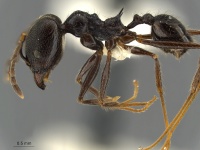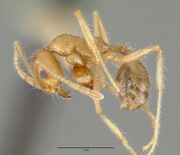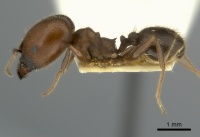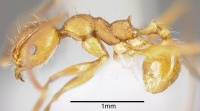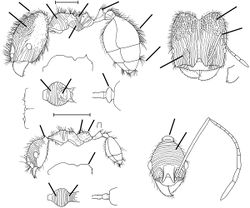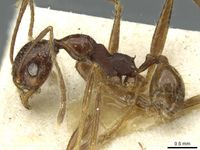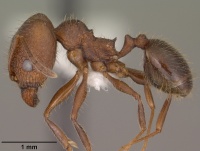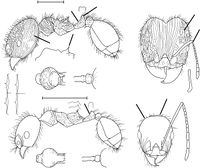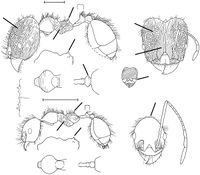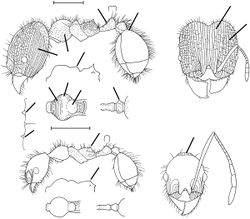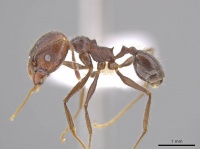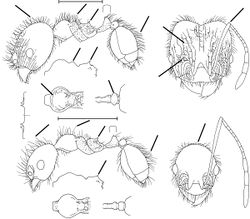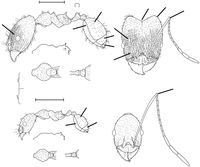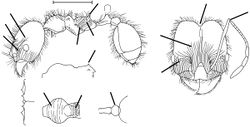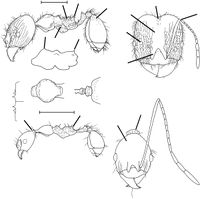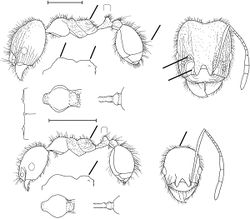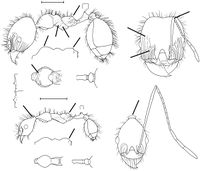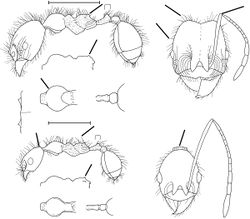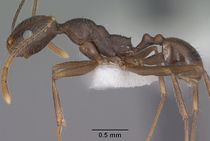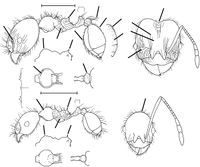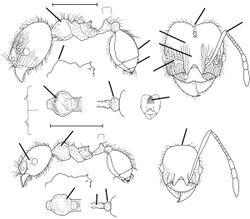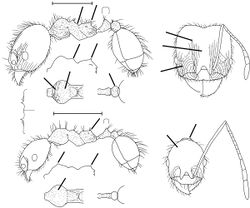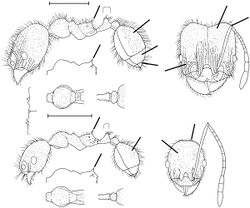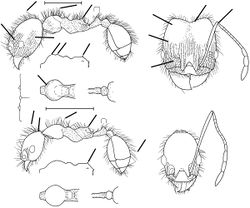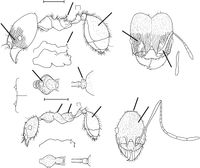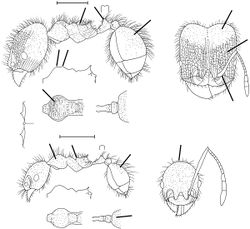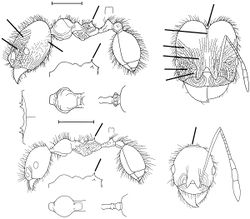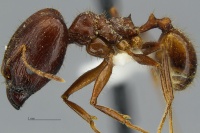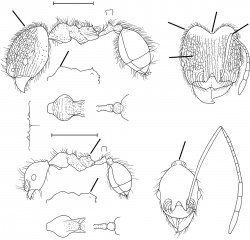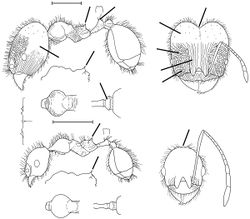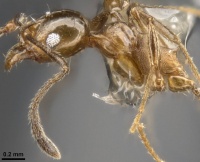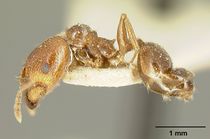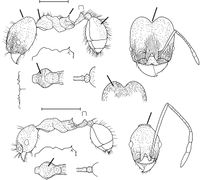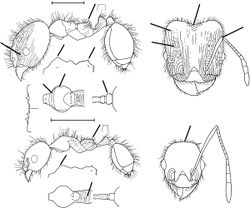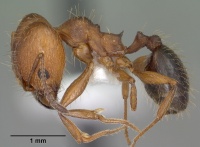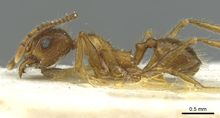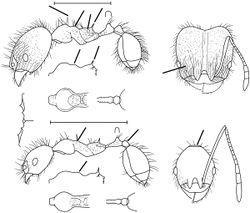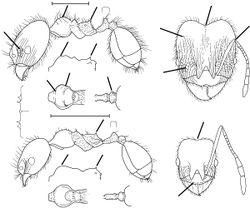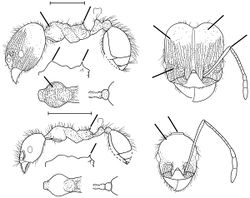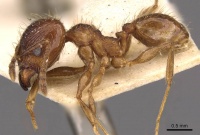Key to Pheidole fallax group
This key species of the Pheidole fallax group is based on Wilson (2003) as modified by Vazquez-Franco et al. (2024).
This large assemblage is matched only by the flavens group in breadth of geographic distribution. Its species range collectively from the southeastern United States to Argentina, both throughout the mainland and on most of the larger islands of the West Indies. Its signature traits are medium size (with the major Head Width of the great majority of species falling between 1.0 and 2.0 mm), relatively long antennal scapes, sides of the major head subparallel, well-developed mesonotal convexity in both major and minor, dense pilosity, and relatively heavy sculpturing, which includes some rugoreticulation on at least the head of the major.
Two species placed in the fallax group known only from the minor caste, Pheidole aequiseta and Pheidole xanthogaster, cannot be identified with the key to follow. Specimens should be checked directly with the figures and measurements provided in the main section of species diagnoses.
1
- Major: seen in full-face view, entire dorsal surface of head, including occipital lobes, covered by carinulae, or rugulae, or rugoreticulum, or some combination of these three types of sculpturing . . . . . 2
- Major: seen in full-face view, either the occipital lobes and/or much of the rest of the posterior half of the head as well, are free of carinulae, rugae, and rugoreticulum, and are instead either smooth or densely foveolate . . . . . . 25
2
return to couplet #1
- Major: scape in repose approaches the occipital corner by 2X or less its own maximum width, or reaches it, or exceeds it.. . . . . . 3
- Major: scape fails to reach the occipital corner by more than 2X its own maximum width . . . . . 12
3
return to couplet #2
- Major and minor: in side view, propodeal spine at least three-fourths as long as the basal face of the propodeum directly anterior to it (Costa Rica) . . . . . 4
- Major and minor: in side view, propodeal spine at most one-third as long as the basal face of the propodeum directly anterior to it. . . . . . 5
4
return to couplet #3
- Major: all of promesonotum covered by parallel transverse carinulae; lower half of mesopleuron covered by parallel longitudinal carinulae; color of body dark brown. Minor: pronotum smooth and shiny . . . . . Pheidole ajax
 Pheidole ajax, Major |
- Major: transverse carinulae limited on promesonotum to anterior third of pro no tum, rugulae present on remainder; carinulae absent from mesopleuron; body reddish yellow to dark brown. Minor: most of pro no tum foveolate and opaque . . . . . Pheidole fiorii
 Pheidole fiorii, Major |
5
return to couplet #3
- Major: rugoreticulum mesad to eye extending all the way posteriorly to the occipital border . . . . . 6
- Major: rugoreticulum mesad to eye ifpresent limited to space between eye and antennal fossa or at most extending posteriorly two-thirds the way from the eye to the occiput . . . . . 8
6
return to couplet #5
- Major: propodeal spine well developed, its height about equal to its width at the base; in side view the dorsal profile of the petiole fonns a straight line from just behind the spiracle to the summit of the node; transverse carinulae absent from the mesonotum (Veracruz, Mexico) . . . . . Pheidole confoedusta (known only from the major)
- Major: propodeal spine low and triangular, its height less than its width at the base; in side view the dorsal profile of the petiole is concave, rising from just behind the spiracle to fonn a distinct anterior face of the node; transverse carinulae present on mesonotum . . . . . 7
7
return to couplet #6
- Major: scape just reaching the occipital corner; only the anterior fourth of the median strip of the first gastral tergite is shagreened and opaque (Santa Catarina, Brazil) . . . . . Pheidole lucretii (known only from the major)
 Pheidole lucretii, Major |
- Major: scape exceeding the occipital corner by more than its own maximum width; all of the median strip of the first gastral tergite shagreened and opaque (Amazonian Peru) . . . . . Pheidole leonina
8
return to couplet #5
- Trimorphic species, with major, supennajor, and minor castes. Major: dorsal surface of head entirely carinulate, lacking rugoreticulum (supennajor: dorsal half of head with scattered foveae, and lacking carinulae) . . . . . 9
- Dimorphic species, with no supennajor caste. Major: at least some of the space between the eye and antennal fossa rugoreticulate . . . . . 10
9
return to couplet #8
- Supermajor: foveae in posterior half of dorsum of head elongate and parallel in direction, their axes oriented longitudinally (southern Arizona through the mountains of western Mexico) (placed in the pilifera group; also keyed out here to ensure identification) . . . . . Pheidole obtusospinosa
 Pheidole obtusospinosa, Major |
- Supermajor: foveae on posterior half of dorsum of head circular in shape (mountains and high plateaus of central and eastern Mexico) (placed in the pilifera group; also keyed out here to ensure identification) . . . . . Pheidole obtusospinosa
 Pheidole obtusospinosa, Major |
10
return to couplet #8
- Major: rugoreticulum mesad to the eye extends slightly more than halfway from eye to level of occipital border. Minor: pronotum and posterior half of dorsal surface of head smooth and shiny (Minas Gerais, Brazil) . . . . . Pheidole cardinalis
- Major: rugoreticulum mesad to the eye limited to space between the eye and antennal fossa. Minor: pronotum and most or all of posterior half of dorsal surface of head foveolate and opaque . . . . . 11
11
return to couplet #10
- Major: carinulae of dorsal surface of the head sparse, and many of the intercarinular spaces smooth and shiny; some of the hairs on the occiput spatulate. Minor: many of the rather sparse hairs on the dorsal profile of the mesosoma, petiole, and postpetiole are spatulate (Costa Rica) . . . . . Pheidole spathipilosa
 Pheidole spathipilosa, Major |
- Major: carinulae on dorsal surface of head dense, with intercarinular spaces all foveolate and opaque. Major and minor: spatulate hairs lacking anywhere on body (Jamaica) . . . . . Pheidole caribbaea
 Pheidole caribbaea, Major |
12
return to couplet #2
- Major: at least the rear third of the dorsum of the head covered by rugoreticulum . . . . . 13
- Major: at least most of the occiput and often most or all of the rest of the dorsum of the head covered by carinulae, not a rugoreticulum . . . . . 17
13
return to couplet #12
- Major: humeri anned with prominent angular extensions that extend beyond the margins of the pronotum when viewed from directly above (Panama) . . . . . Pheidole caltrop
 Pheidole caltrop, Major |
- Major: humeri not armed . . . . . 14
14
return to couplet #13
- Major pronotum rugoreticulate . . . . . 14a
- Major: pronotum transversely carinulate . . . . . 15
14a
return to couplet #14
- Major: Petiole and postpetiole foveolate and faintly carinulate . . . . . Pheidole gulo
 Pheidole gulo, Minor |
- Major: Petiole and postpetiole foveolate without carinula . . . . . Pheidole rojasae
15
return to couplet #14
- Major: dorsum of head mesad to the eyes and proceeding to a level well in advance of the eyes rugoreticulate; sides of pronotum carinulate. Minor: propodeum with well-developed spine (Argentina, Paraguay, introduced into Gulf Coast of Alabama and Florida) . . . . . . Pheidole obscurithorax
 Pheidole obscurithorax, Major |
- Major: areas mesad and anterior to the eyes carinulate only, not rugoreticulate; sides of pronotum carinulate or not. Minor: propodeal spine present or absent . . . . . 16
16
return to couplet #15
- Major: lower halves of pronotum and mesopleuron and anterior third of side of propodeum transversely carinulate. Minor: lacking propodeal spines; occiput transversely carinulate (Choco, Colombia) . . . . . Pheidole tigris
- Major: lower halves of mesopleuron and pronotum and anterior third of side of propodeum foveolate only, lacking carinulae. Minor: propodeal spines present; occiput rugoreticulate (Texas) . . . . . Pheidole texana
 Pheidole texana, Major |
17
return to couplet #12
- Major: dorsum of occiput covered by concentric semicircular carinulae that run parallel to the borders of the occipital lobes (Minas Gerais, Brazil) . . . . . Pheidole arcifera
 Pheidole arcifera, Major |
- Major: dorsum of occiput covered by parallel longitudinal carinulae that do not curve parallel to the occipital lobes . . . . . 18
18
return to couplet #17
- Major: carinulae originating on the frontal lobes continue unbroken posteriorly to the occipital border . . . . . 19
- Major: at least some of the carinulae originating on the frontal lobes break up into a rugoreticulum before reaching the occipital border . . . . . 22
19
return to couplet #18
- Major: in full-face view, profile of entire half of the head posterior to the eyes ringed by a uniform, dense fringe of short, semirecumbent hairs; rugoreticulum on head limited to a very small area (not much greater in extent than the area of the eye) just mesad of the circular carinulae around the antennal fossae (Costa Rica) . . . . . Pheidole mantilla
- Major: hairs around full-face margin of head posterior to the eyes erect to suberect, very variable in length, not forming a uniform fringe; rugoreticulum at the very least extending from the circular carinulae around the antennal fossae all the way to the eye . . . . . 20
20
return to couplet #19
- Major: carinulae on the genae (laterad to the eye) extending only halfway from the level of the posterior margin of the eye to the level of the occipital lobes; in dorsal oblique view (mesosoma rotated around long axis 45 degrees from top view), the pronotal profile forms the arc of a circle and is only about as high as the mesonotal convexity behind it. Minor: dorsal surface of head and all of pronotum foveolate and opaque (southwestern U. S., Colorado) (also, check hyatti) . . . . . Pheidole cockerelli
 Pheidole cockerelli, Major |
- Major: carinulae on the genae extend posteriorly all the way to the level of the occipital lobes; in dorsal-oblique view, the pronotal profile bulges upward as a rounded right angle much higher than the mesonotal convexity behind it. Minor: dorsal surface of head and most or all of pro no tum smooth and shiny . . . . . 21
21
return to couplet #20
- Major and minor: in profile, petiolar node very prominent, its summit running anteriorly through a strong concavity to the peduncle and dropping posteriorly through a nearly vertical face to the postpetiolar junction. Major: in side view, occiput is relatively narrow, and the profile of the posterior half of the dorsal surface of the head just in front of it is straight or nearly so; scape shorter, 0.50-0.59X Head Width. Minor: occiput broader, with the nuchal collar very thin and barely discernible in full-face view (Cuba, Jamaica, Central America, Colombia, Venezuela) . . . . . Pheidole fallax
 Pheidole fallax, Major |
- Major and minor: in profile, petiolar node much less distinct, its summit running anteriorly to the peduncle through a shallow convexity and posteriorly through a shallow, oblique convexity to the postpetiolar junction. Major: in side view, occiput broader, with the profile of the posterior half of the dorsum of the head anterior to the occiput moderately convex; scape longer, its length 0.60-0.70 X Head Width. Minor: occiput narrower, with the collar prominent in full-face view (extremely abundant, especially in disturbed environments, through the West Indies and South Americas as far south as northern Argentina) . . . . . Pheidole jelskii
 Pheidole jelskii, Major |
22
return to couplet #18
- Large species (Head Width of major about 2.0 mm). Major: gena (surface of head laterad to eye) in side view entirely covered by carinulae all the way posteriorly to the occiput . . . . . 23
- Small species (Head Width of major l.3-l.7 mm). Major: most of gena in side view free of carinulae, instead either densely foveate and opaque or smooth and shiny . . . . . 24
23
return to couplet #22
- Major and minor: mesopleuron covered by longitudinal carinulae. Major: in full-face view, scape reaching margin of head nearly halfway from level of eye to level of occipital border; propodeal spine in side view narrow, forming a triangle with sides longer than the base (Costa Rica) . . . . . Pheidole hirsuta
 Pheidole hirsuta, Major |
- Major and minor: mesopleuron lacking carinulae. Major: in full-face view, scape reaching margin of head only about one-fourth the distance from the level of eye to level of occipital border; propodeal spine in side view with sides only as long as the base (Brazil) . . . . . Pheidole gigas
24
return to couplet #22
- Major: pronotal dorsum covered by broken transverse carinulae, and mesopleuron by broken longitudinal carinulae. Minor: dorsal surface of head smooth and shiny; head narrowed posteriorly, with a nuchal collar posterior to the occiput (Amazonian Peru) . . . . . Pheidole tobini
- Major: pronotal dorsum not carinulate, but with a small patch of rugoreticulum on the humeri; mesopleuron lacking carinulae also. Minor: dorsal surface of head foveolate and opaque, and with scattered longitudinal carinulae; occiput broad, lacking nuchal collar (Arizona) . . . . . Pheidole perpilosa
 Pheidole perpilosa, Major |
25
return to couplet #1
- Major: antennal scapes approach the occipital corners to within 1.5X their own maximum width, reach the corners, or exceed them . . . . . 26
- Major: antennal scapes fail to reach the occipital corners by 2X or more their own maximum width . . . . . 62
26
return to couplet #25
- Major: antennal scapes exceed the occipital corners by 5X their own maximum width, or a distance equal to half the distance from the level of the posterior margin of the eye to the level of the occipital margin (southern California, northern Mexico) . . . . . Pheidole vistana
 Pheidole vistana, Major |
- Major: antennal scapes, if they exceed the occipital corner, do so by no more than 3X their own maximum width, or about one-fourth the distance from the level of the eye to the level of the occipital margin . . . . . 27
27
return to couplet #26
- Major: either frontal lobes covered by rugoreticula or else multiple carinulae arising on the frontal lobes break up into strongly developed rugoreticula on the lobes or posteriorly to them, with multiple cross-carinulae . . . . . 28
- Major: either carinulae (and rugoreticula) absent on frontal lobes or else if multiple carinulae arise there, they do not break up posteriorly into well-developed rugoreticula . . . . . 36
28
return to couplet #27
- Major: frontal lobes covered mostly or entirely by rugoreticulum . . . . . 29
- Major: frontal lobes covered mostly or entirely by carinulae or smooth areas, not by rugoreticulum . . . . . 32
29
return to couplet #28
- Major: half or more of pro notal dorsum covered by rugoreticulum; median ocellus present (montane Tamaulipas, Mexico) (placed in the punctatissima group; also keyed out here to ensure identification; see also Pheidole inca in punctatissima group) . . . . . 30
- Major: pronotal dorsum lacking rugoreticulum; at most, its anterior half with a few broken carinulae or nonreticulate rugulae; ocelli absent . . . . . 31
30
return to couplet #29
- Major: in full-face view, rugoreticulum extends past the level of the margin of the eye for a distance halfway to the level of the posteriormost occipital margin; head bicolored, with anterior one-fourth dark yellow and posterior three-fourths medium brown . . . . . Pheidole nubicola
- Major: in full-face view, rugoreticulum extends past the level of the posterior margin of the eye for a distance only about equal to the length of the eye; entire head light to medium reddish brown . . . . . Pheidole nubicola
31
return to couplet #29
- Major: broken rugulae present on occiput in full-face view as well as on anterior third of pronotal dorsum. Minor: head and pronotum foveolate and opaque (montane Veracruz, Mexico) . . . . . Pheidole roushae
 Pheidole roushae, Major |
- Major: rugulae absent on occiput and pronotal dorsum. Minor: head and pronotal dorsum smooth and shiny (Costa Rica) . . . . . Pheidole indagatrix
 Pheidole indagatrix, Major |
32
return to couplet #28
- Major: vertex to mid-occiput, seen in full-face view, covered by loose, isolated patch of rugoreticulum, occipital lobes and space between vertex and central triangle smooth and shiny (Para, Brazil) . . . . . Pheidole aenescens
- Major: vertex and mid-occiput either lacking rugoreticulum or, if rugoreticulum is present, it is dense and solidly connected with surrounding, equally dense rugoreticula of dorsal head surface . . . . . 33
33
return to couplet #32
- Major: scapes exceeding margins of occipital lobes by at least 2X their own width . . . . . 34
- Major: scapes just reaching margins of occipital lobes . . . . . 35
34
return to couplet #33
- Major: in full face view, no hairs break past the margin of the head except along the anterior margin of the clypeus; weak transverse carinulae present on pronotal dorsum. Minor: head drawn out posteriorly into a neck, followed by a nuchal collar more than half as long as the eye; head and pronotal dorsum smooth and shiny (Brazil, Peru) . . . . . Pheidole cuevasi
 Pheidole cuevasi, Major |
- Major: in full-face view, a dense fringe of hairs project beyond the margin of the head everywhere except the inner margins of the occipital lobes; pronotal dorsum lacking carinulae. Minor: head narrowed somewhat at occiput but not into a neck, and nuchal collar is less than one-fourth as long as the eye; dorsal surfaces of head and pronotum foveolate and opaque (Morelos, Mexico) . . . . . Pheidole skwarrae
 Pheidole skwarrae, Major |
35
return to couplet #33
- Major: in full-face view, rugoreticulum and carinulae covering all of dorsal surface of head except occipital lobes; in profile, posterior dorsal third of head capsule (just anterior to the occipital lobes) weakly concave; many hairs on dorsa of head and mesosoma 1.5X as long as length of eye, or longer; bicolored, with head reddish yellow and body medium brown (montane Venezuela) . . . . . Pheidole rubiceps
- Major: in full-face view, rugoreticulum and carinulae extend posteriorly past level of eye only about as much as length of eye; in profile, posterior dorsal third of head capsule moderately convex; hairs on dorsa of head and mesosoma shorter than eye length; concolorous medium brown, with anterior rim of head capsule yellowish brown (central Mexico) (also, check tijucana) . . . . . Pheidole tolteca
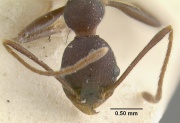 Pheidole tolteca, Major |
36
return to couplet #27
- Major: in full-face view, carinulae completely cover frontal lobes, and they do not travel straight back on leaving the lobes but fan out posteriorly to create a broad spreading array behind the lobes, with the carinulae from the outer edges of the array turning almost horizontally to reach the space just above the eye (montane Peru) . . . . . Pheidole kugleri (known only from the major)
- Major: carinulae either absent over most or all of the frontal lobes or, if they cover the lobe, travel straight back on leaving the lobes . . . . . 37
37
return to couplet #36
- Major: in side view, propodeal spine more than a third as long as the basal face of the propodeum just anterior to it. Minor: propodeal spine as long as basal face of propodeum, or longer . . . . . 38
- Major and minor: in side view, propodeal spine no more than one-fourth as long as the basal face of the propodeum just anterior to it, and in many species it is reduced to a denticle . . . . . 39
38
return to couplet #37
- Major: mesopleuron covered by weak longitudinal carinulae; posterior half of dorsum of head foveolate and opaque; head bicolored, with genae anterior to eye yellow and rest of head medium brown (montane southern Costa Rica) . . . . . Pheidole hector
- Major: mesopleuron lacking carinulae; posterior half of dorsum of head smooth and shiny; head concolorous light brown (Amazonian Brazil) . . . . . Pheidole jaculifera
39
return to couplet #37
- Major: lower half of mesopleuron covered by parallel longitudinal carinulae . . . . . 40
- Major: lower half of mesopleuron lacking carinulae or with at most 2-3 next to lower margin . . . . . 41
40
return to couplet #39
- Major: rugoreticulum and carinulae mesad to eye reaching four-fifths the way from the eyes to the margins of the occipital lobes. Minor: mesopleuron lacking carinulae (Rio de Janeiro, Brazil) . . . . . Pheidole tijucana
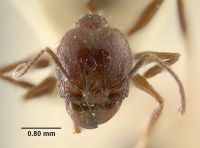 Pheidole tijucana, Major |
- Major: rugoreticulum and carinulae mesad to eye reaching only halfway from the eyes to the margins of the occipital lobes. Minor: lower two-thirds of mesopleuron covered by longitudinal carinulae (Choco, Colombia) . . . . . Pheidole chocoensis
 Pheidole chocoensis, Major |
41
return to couplet #39
- Major and minor: pilosity very sparse; seen from side, dorsal profile of mesosoma with fewer than 10 hairs in major and completely bare in minor (Rio de Janeiro, Brazil) (antennae of available specimen missing; keyed out here and later to cover both lugs of couplet 25) . . . . . Pheidole punctithorax (in part - also #84)
 Pheidole punctithorax, Minor |
- Major and minor: pilosity dense, including that projecting above mesosomal profile . . . . . 42
42
return to couplet #41
- Major: frontal lobes completely lacking carinulae . . . . . 43
- Major: frontal lobes bearing at least 1 or 2 carinulae on each of the lobes that extend for at least part of the length of the lobes . . . . . 47
43
return to couplet #42
- Major: in full-face view, carinulae mesad to the eyes extend posteriorly over three-fourths the distance from the level of the posterior margins of the eyes to the level of the occiput; scape just reaches occipital corner (Nayarit, Mexico) . . . . . Pheidole hamtoni
- Major: in full-face view, carinulae mesad to the eyes reach at most one-third the distance from the level of the posterior margins of the eyes to the level of the occiput, scape just reaches occipital corner or exceeds it . . . . . 44
44
return to couplet #43
- Major: scape just reaching occipital corner; transverse carinulae cover anterior third of pronotal dorsum. Major and minor: color dark yellow (Amazonian Brazil) . . . . . Pheidole araneoides
 Pheidole araneoides, Minor |
- Major: scape exceeds occipital border by 1-2 X its own greatest width; transverse carinulae present or absent on anterior third of pro notal dorsum. Major and minor: color yellow or brown . . . . . 45
45
return to couplet #44
- Major: large (Head Width l.7 mm), reddish yellow (Amazonian Brazil) . . . . . Pheidole wallacei
 Pheidole wallacei, Major |
- Major: smaller (Head Width 0.8-l.2 mm), brown . . . . . 46
46
return to couplet #45
- Major: head narrowed at occiput, l.1 X longer than broad; rugoreticulum on head limited to a small patch just mesad and anterior to eye; pronotum completely bare of carinulae. Minor: pronotum completely smooth and shiny (Amazonian Peru) . . . . . Pheidole leptina
- Major: head of typical Pheidole shape, almost as broad as long; rugoreticulum on head extensive between eye and antennal fossa; pronotum with broken carinulae on anterior third of dorsum. Minor: lateral edges of pronotal dorsum foveolate and opaque (southeastern Brazil) . . . . . Pheidole wolfringi
 Pheidole wolfringi, Major |
47
return to couplet #42
- Major: head lacking any rugoreticulum (Arizona) . . . . . Pheidole portalensis
 Pheidole portalensis, Major |
- Major: at least some rugoreticulum present between eye and antennal fossa . . . . . 48
48
return to couplet #47
- Major: surface of first 3 gastral tergites covered by very short, completely appressed hairs; in addition, anterior half of dorsum of first gastral tergite (upper surface of first gastral segment) viewed in profile lined with uniform, slightly longer subrecumbent hairs (most about the width of the propodeal spiracles), and gastral sternites (lower surface of gaster) also with u.niform, suberect hairs half the length of the eye; this uniquely mixed gastral pilosity is in contrast to the longer, irregular pilosity on the rest of the body (Mexico, Nicaragua) . . . . . Pheidole psilogaster
 Pheidole psilogaster, Major |
- Major: appressed hairs and other pilosity of gaster other than described above . . . . . 49
49
return to couplet #48
- Major: in profile, first 2 gastral tergites covered by a dense, uniform pile of suberect hairs slightly shorter than the width of the propodeal spiracle; in addition, anterior half of first 2 gastral tergites bear “normal” suberect hairs of variable length (central and northeastern Mexico) . . . . . Pheidole potosiana
- Major: pilosity of gaster other than described above . . . . . 50
50
return to couplet #49
- Major: at least several parallel “wraparound” carinulae cover anterior fifth or more of the pronotal dorsum (seen from above) and continue curving down to cover the lower fifth or more of the sides of the pronotum (seen from the side) . . . . . 51
- Major: pronotum lacking “wraparound” carinulae . . . . . 54
51
return to couplet #50
- Major: rugoreticulum and carinulae immediately mesad to the eye extend posteriorly beyond the eye to halfway between level of the eye and level of the occipital border . . . . . 52
- Major: rugoreticulum and carinulae immediately mesad to the eye extend posteriorly beyond the eye for a distance only about the length of the eye . . . . . 53
52
return to couplet #51
- Major: parallel transverse carinulae, even though weak, cover all of dorsum of pronotum; a patch of the anterior strip of the median half of the first gastral tergite shagreened and opaque (Nicaragua to Venezuela) . . . . . Pheidole kukrana
 Pheidole kukrana, Minor |
- Major: center of pronotal dorsum lacking carinulae; first gastral tergite entirely smooth and shiny (West Indies, Central and South America) . . . . . Pheidole obscurior (= Pheidole susannae)
 Pheidole susannae, Major |
53
return to couplet #51
- Major: pronotal dorsum and dorsa of petiolar and postpetiolar nodes foveolate and opaque. Minor: pronotum foveolate and opaque; some of the hairs on pronotal dorsum longer than the eye (southeastern Brazil) . . . . . Pheidole nesiota
- Major: pronotal dorsum and dorsa of petiolar and postpetiolar nodes smooth and shiny. Minor: pronotal dorsum smooth and shiny; hairs on pronotal dorsum shorter than length of eye (southwestern Texas) . . . . . Pheidole sitiens
 Pheidole sitiens, Major |
54
return to couplet #50
- Minor: occiput with nuchal collar . . . . . 55
- Minor: occiput lacking nuchal collar, even when occiput is strongly narrowed . . . . . 58
55
return to couplet #54
- Major: pronotal dorsum foveolate and opaque; median half of first 3 gastral tergites entirely shagreened and opaque (Morelos, Mexico) . . . . . Pheidole nubicola
- Major: pronotal dorsum mostly smooth and shiny; shagreening on gaster limited to small patch on first tergite just behind the postpetiolar junction . . . . . 56
56
return to couplet #55
- Major: carinulae just mesad to eye extending beyond eye for a distance halfway to the level of the occipital border (Argentina) . . . . . Pheidole durionei
 Pheidole durionei, Major |
- Major: carinulae just mesad to the eye extending beyond the eye for a distance only about as great as the length of the eye . . . . . 57
57
return to couplet #56
- Major: antennal scape just reaching margin of occipital corner; pronotal profile with two shallow but distinct convexities; dorsal profile of petiolar peduncle with standing hairs (Amazonian Peru) . . . . . Pheidole lupus
- Major: antennal scape surpassing margin of occipital corner by about its own maximum width; pronotal profile a single, smoothly continuous convexity; hairs absent from dorsum of petiolar peduncle (Bolivia, Ecuador) . . . . . . Pheidole haskinsorum
58
return to couplet #54
- Major: frontal lobe area completely covered by parallel longitudinal carinulae, up to and including those arising from the posterior border of the frontal triangle to travel along the dorsal midline of the head. Minor: in side view, propodeal spine reduced to an obtuse angle formed by the basal and declivitous faces of the propodeum (vic. Mexico City) (placed in the pilifera group; also keyed out here to ensure identification) . . . . . Pheidole azteca
 Pheidole azteca, Major |
- Major: a large space between the frontal lobes, posterior to and at the very least as wide as the frontal triangle, devoid of carinulae. Minor: in side view, the propodeal spine is well developed, at the very least as a sharp denticle projecting up from the juncture of the basal and declivitous faces of the propodeum . . . . . 59
59
return to couplet #58
- Major: rugoreticulum of dorsum of head extends to fill space between eye and the anterior genal border; sides of pro no tum foveolate and opaque (southwestern U. S., California, northern Mexico) (check against cockerelli) . . . . . Pheidole hyatti
 Pheidole hyatti, Major |
- Major: rugoreticulum of head limited to space between eyes and frontal lobes, not extending to area anterior to the eyes . . . . . 60
60
return to couplet #59
- Major: postpetiolar node seen from above oval, its lateral margins not sub angular; dorsal profile of petiolar node (viewed from rear) strongly convex; pronotal profile, in dorsal-oblique view (mesosoma rotated around long axis 45 degrees from top view) smoothly rounded, as an arc of a circle. Major and minor: yellow (Panama, northern and central South America) . . . . . Pheidole midas
- Major: postpetiolar node in dorsal-oblique view with sub angular lateral margins; dorsal profile of petiolar node (viewed from rear) flat or slightly concave; pronotal profile, seen from above and obliquely, subangulate. Major and minor: yellow or brown . . . . . 61
61
return to couplet #60
- Major: almost all of the dorsal surface of the head between the frontal lobes and occipital lobes foveolate and opaque; carinulae absent from pronotum. Minor: in full-face view, head strongly constricted behind, yet the occipital border is concave and nuchal collar is absent. Major and minor: yellow (southwestern U. S.) . . . . . Pheidole desertorum
 Pheidole desertorum, Major |
- Major: all of the space between the frontal lobes and occiput smooth and shiny; transverse carinulae present on anterior fifth of pronotum. Minor: head not narrowed; occiput broad and convex. Major and minor: brown (eastern Mexico) (placed in the crassicornis group; also keyed out here to ensure identification) . . . . . Pheidole fariasana (= Pheidole insipida)
 Pheidole insipida, Major |
62
return to couplet #25
- Major: antennal scape much wider near its insertion than anywhere along its distal half . . . . . 63
- Major: antennal scape along its distal half as wide as or wider than near its insertion . . . . . 64
63
return to couplet #62
- Major: parallel longitudinal carinulae occur all across the frontal lobes and posterior to them, as well as anterior half of the pronotal dorsum (Brazil, Bolivia) . . . . . Pheidole claviscapa
 Pheidole claviscapa, Minor |
- Major: most of frontal lobes and region posterior to them, as well as on anterior half of the pronotal dorsum, are rugoreticulate (Mato Grosso, Brazil) . . . . . Pheidole valens (in part - also #84)
64
return to couplet #62
- Major: rugulae originating ,near the posterior outer margins of the frontal lobes travel laterally or obliquely to the lateral margins of the head above the eyes . . . . . 65
- Major: any rugulae or carinulae that originate near the posterior outer margins of the frontal lobes travel more or less straight back and not to the sides of the head . . . . . 66
65
return to couplet #64
- Major: rugulae departing from the posterior outer margins of the outer margins of the frontal lobes travel laterally to the eyes; dorsal surface of the head directly posterior to the frontal triangle lack rugulae or carinulae. Major and minor: propodeal spine reduced to a denticle (Colombia) . . . . . Pheidole oliveirai
- Major: rugulae departing from the posterior outer margins of the frontal lobes travel obliquely upward to the sides of the head above the eyes; dorsal surface of the head posterior to the frontal triangle bears rugulae that extend most or all the way to the occiput. Major and minor: propodeal spine well developed, in side view about one-fourth as long as the basal face anterior to it (Peru) . . . . . Pheidole huacana
66
return to couplet #64
- Major: no rugoreticulum on head, only parallel longitudinal carinulae . . . . . 67
- Major: rugoreticulum present between eye and antennal fossa and of ten elsewhere on head . . . . . 71
67
return to couplet #66
- Major: medium-sized (Head Width about 1.0-1.3 mm); propodeal spine reduced to denticle or, if present, forms a 135-degree angle with the basal face of the propodeum in side view (U. S., northern Mexico) . . . . . 68
- Major: large to very large (Head Width 1.9-2.5 mm); propodea1 spine strongly developed and projects perpendicularly up from the basal face of the propodeum in side view (South America) . . . . . 69
68
return to couplet #67
- Major: propodeal spine reduced to a barely perceptible denticle whose apex forms a right angle; most of frontal lobes smooth. Minor: posterior half of dorsal head surface smooth (New York to Florida, west to Texas) . . . . . Pheidole morrisii
 Pheidole morrisii, Major |
- Major: propodeal spine strongly developed, about one-third as long as basal surface of propodeum anterior to it; frontal lobes covered by carinulae. Minor: posterior half of dorsal head surface foveolate and opaque (central Texas to California and Chihuahua) . . . . . Pheidole sciophila
 Pheidole sciophila, Major |
69
return to couplet #67
- Major: carinulae cover most of the genae posterior to the eye, as well as anterior and lateral margins of the pronotum and all of the sides of the propodeum (Colombia, Ecuador) . . . . . Pheidole praeusta
 Pheidole praeusta, Major |
- Major: carinulae do not extend posteriorly beyond the eye for a distance greater than the length of the eye; carinulae absent from all but the posterior lower quarter of the side of the propodeum (Brazil) ..... . . . . . 70
70
return to couplet #69
- Major: postpetiole seen from above ellipsoidal with subangulate margins; humerus in dorsal-oblique view (mesosoma rotated around long axis 45 degrees from top view) 2-lobed; anterior fourth of pro no tum transversely carinulate. Minor: reddish brown (Argentina, Paraguay, southern and central Brazil) (placed in the diligens group; also keyed out here to ensure identification) . . . . . Pheidole oxyops
 Pheidole oxyops, Major |
- Major: postpetiole seen from above trapezoidal; humerus in dorsal-oblique view single-lobed and subangulate; pronotum entirely smooth, not carinulate. Minor: pronotum foveolate. Major and minor: yellow (Mato Grosso, Brazil) . . . . . Pheidole trageri
71
return to couplet #66
- Major: entire dorsal profile of body (head, mesosoma, waist, and gaster) covered by uniformly dense, almost perfectly erect, bristle-like hairs, which are about the length of the eye. Relatively large species (Head Width of major 1.7- 2.3 mm) . . . . . 72
- Major: pilosity not uniformly erect over entire body dorsum nor of nearly uniform length on each body part in tum; size variable . . . . . 73
72
return to couplet #71
- Major: seen in full-face view, all of dorsal surface of head between eyes and frontal lobes, except for occipital lobes, covered by parallel longitudinal carinulae; pronotal dorsum smooth and shiny; very large (Head Width 2.2-2.3 mm), reddish yellow (Guianas to Peru) . . . . . Pheidole astur
 Pheidole astur, Major |
- Major: seen in full-face view, parallel longitudinal carinulae between eyes and frontal lobes extend only halfway from level of posterior margins of the eyes to the level of the occipital lobes; anterior fourth of pronotal dorsum bearing parallel transverse carinulae, or else its entire surface foveolate and opaque; small (Head Width 1.7- 2.0 mm) (Mexico, Costa Rica) . . . . . Pheidole gouldi
 Pheidole gouldi, Major |
73
return to couplet #71
- Major: in side view, posterior half of dorsal profile of head, including profile of occiput, covered by a very dense layer of oblique, forward-directed hairs (making an angle of about 45 degrees with the surface), and of uniform length (less than the length of the eye), the whole forming a felt-like layer strikingly different from the pilosity on the rest of the body . . . . . 74
- Major: lacking a dense, specialized layer of hairs on the dorsal profile of the head as described above . . . . . 77
74
return to couplet #73
- Major: rugoreticulum a loose network, its cells half as long as the eye or longer and smooth and shiny; propodeal spine short, its apex forming a right angle. Minor: propodeal spine absent, the juncture of the basal and declivitous propodeal faces seen in side view a smooth, convex curve (Amazonian Brazil) . . . . . Pheidole paraensis
- Major: rugoreticulum tight and dense, its cells less than half as long as the eye and opaque; propodeal spine well developed, its apex forming an acute angle. Minor: propodeal spine well developed, at least as a denticle . . . . . 75
75
return to couplet #74
- Major: rugoreticulum on dorsal surface of head extending posteriorly to three-fourths the distance from the eye to the occipital corner; lower anterior half of mesopleuron bearing parallel longitudinal carinulae (Venezuela) . . . . . . Pheidole lattkei
- Major: rugoreticulum on dorsal surface of head extending less than one-fourth the distance from the eye to the occipital corner; lower anterior half of mesopleuron lacking carinulae . . . . . 76
76
return to couplet #75
- Major: carinulae around the dorsal midline of the head reach the occipital border; anterior fourth of pro no tum covered by parallel carinulae; in side view, slope of petiole from summit of node to junction with propodeum is strongly concave; reddish brown (Amazonian Brazil and Peru) . . . . . Pheidole cursor
 Pheidole cursor, Major |
- Major: carinulae around the dorsal midline of the head fail to reach the occiput; anterior fourth of pro no tum with at most a faint trace of carinulae; in side view, slope of petiole from summit of node to junction with propodeum is straight; brownish yellow (Venezuela to Peru) . . . . . Pheidole lanigera
77
return to couplet #73
- Major: mesopleuron carinulate or rugulate . . . . . 78
- Major: mesopleuron lacking carinulae or rugulae . . . . . 82
78
return to couplet #77
- Major: in side view, propodeal spine half as long as the basal face anterior to it; pronotal dorsum with scattered rugulae, the intervening surface foveolate and opaque (Costa Rica) . . . . . Pheidole lourothi
- Major: in side view, propodeal spine one-fourth as long as the basal face anterior to it, or less; pronotal dorsum carinulate or bare, mostly lacking foveolae, its surface shiny . . . . . 79
79
return to couplet #78
- Major: in full-face view, head capsule rectangular in outline; anterior three-fourths of median half of first gastral tergite shagreened and opaque. Minor: in full-face view, occiput narrowed strongly to create a neck, followed by a nuchal collar (Argentina and Minas Gerais, Brazil) . . . . . Pheidole jujuyensis
 Pheidole jujuyensis, Minor |
- Major: in full-face view, head capsule roughly heart-shaped in outline; at most, anterior half of median half of first gastral tergite shagreened and opaque. Minor: occiput narrowed but not forming a distinct neck, and nuchal collar either present or not . . . . . 80
80
return to couplet #79
- Major: carinulae running along dorsal midline of head extend posteriorly all the way to the occipital border; antennal scape reaching only one-fourth the distance from the level of the eye to the margin of the occipital corner. Minor: nuchal collar absent (Colombia) (placed in the tristis group; also keyed out here to ensure identification) . . . . . Pheidole steinheili
 Pheidole steinheili, Major |
- Major: carinulae running along dorsal midline of head fail to reach occipital border by a distance at least 3X the length of the eye; antennal scape reaching at least one-half the distance from the level of the eye to the margin of the occipital corner. Minor: nuchal collar present . . . . . 81
81
return to couplet #80
- Major: sides of propodeum anterior to spiracle covered by parallel transverse carinulae; occipital lobes sprinkled with conspicuous foveae; in side view, apex of petiolar node acute; body light reddish yellow. Minor: propodeal spine strongly developed, one-fourth as long as the basal propodeal face anterior to it (Amazonian Peru) . . . . . Pheidole galba
- Major: sides of propodeum anterior to spiracle lacking carinulae; occipital lobes lack conspicuous foveae; in side view, apex of petiolar node square; body brown. Minor: propodeal spine reduced to denticle a tenth the length of the basal propodeal face, or less (Amazonian Brazil) . . . . . Pheidole lovejoyi
82
return to couplet #77
- Major: anterior third of pro notal dorsum rugoreticulate . . . . . 83
- Major: anterior third of pro notal dorsum smooth, transversely carinulate, or transversely rugulose, but not reticulate . . . . . 85
83
return to couplet #82
- Major: in side view, profile of first gastral tergite fringed by a dense row of short, oblique hairs of uniform length about one-fourth as long as the eye. Minor: in full-face view, lacking a nuchal collar. Major and minor: body yellow (Nicaragua) . . . . . Pheidole acamata
 Pheidole acamata, Major |
- Major: in side view, profile of first gastral tergite fringed by erect to sub erect hairs, many or most of which are more than half as long as the eye or longer. Minor: in full-face view, a nuchal collar is visible. Major and minor: body reddish brown . . . . . 84
84
return to couplet #83
- Major: basal face of propodeum covered by prominent, parallel transverse carinulae; in side view, propodeal spine nearly one-half as long as the basal face of the propodeum anterior to it; gastral hairs very dense and longer than the eye (Mato Grosso, Brazil) . . . . . Pheidole valens (in part - also #63)
- Major: basal face of propodeum lacks transverse carinulae; in side view, propodeal spine only one-tenth as long as basal face of propodeum anterior to it; gastral hairs very sparse and somewhat shorter than the eye (Rio de Janeiro, Brazil) (antennae of available specimen missing; keyed out here and previously to cover both lugs in couplet 25) . . . . . Pheidole punctithorax (in part - also #41)
 Pheidole punctithorax, Minor |
85
return to couplet #82
- Major: seen in full face, profile of the entire margin of the head other than the anterior clypeal border lacks hairs or at most has 2 or 3 hairs extending past the margin . . . . . 86
- Major: seen in full face, profile of the entire margin of the head other than the anterior clypeal border with at least 6 hairs extending beyond the margin . . . . . 89
86
return to couplet #85
- Major: rugoreticulum mesad to the eyes extends three-fourths the distance from the posterior borders of the eyes to the level of the margins of the occipital lobes; in side view, the mesonotal convexity is extremely prominent, as high as it is broad at the base (Costa Rica) (placed in the diligens group; also keyed out here to ensure identification) . . . . . Pheidole plebecula
 Pheidole plebecula, Minor |
- Major: rugoreticulum mesad to the eyes not extending posteriorly beyond the posterior borders of the eyes; in side view, the mesonotal convexity is prominent but only about half as high as it is wide at the base . . . . . 87
87
return to couplet #86
- Major: in full-face view, posterior half of dorsum of head capsule smooth and shiny. Minor: posterior half of dorsum of head capsule and all of pronotum smooth and shiny (Guatemala) . . . . . Pheidole maja
 Pheidole maja, Major |
- Major: in full-face view, posterior half of dorsum of head capsule completely foveolate and opaque. Minor: posterior half of dorsum of head and all of pronotum completely foveolate and opaque . . . . . 88
88
return to couplet #87
- Major: in side view, profile of posterior third of head weakly concave; dorsal surface of occipital lobes covered by sparse, completely appressed short yellow hairs; central half of first gastral tergite shagreened and opaque. Minor: occiput with nuchal collar (Amazonian Peru) (placed in the biconstricta group; also keyed out here to ensure identification) . . . . . Pheidole fissiceps
 Pheidole fissiceps, Minor |
- Major: in side view, profile of posterior third of dorsum of head moderately convex; dorsal surface of occipital lobes lacking appressed yellow hairs; first gastral tergite entirely smooth and shiny. Minor: occiput lacking nuchal collar (Morelos, Mexico) . . . . . Pheidole optiva
 Pheidole optiva, Major |
89
return to couplet #85
- Major: anterior third of first gastral tergite covered by parallel longitudinal fine striae; mesonotal dorsum transversely carinulate (northeastern Brazil) . . . . . Pheidole impressa
 Pheidole impressa, Major |
- Major: first gastral tergite lacking longitudinal striae; mesonotal dorsum transversely carinulate or not . . . . . 90
90
return to couplet #89
- Major: profile of humerus in dorsal-oblique view (mesosoma rotated around long axis 45 degrees from top view) is subangulate, forming an obtuse angle with or without a denticle (see drawings of species that follow in order to clarify distinction. . . . . 91
- Major: profile of humerus seen in dorsal-oblique view, smoothly rounded convexity . . . . . 95
91
return to couplet #90
- Major: sides of pronotum covered by curving, “wraparound” carinulae (Brazil, Argentina) . . . . . Pheidole puttemansi
 Pheidole puttemansi, Major |
- Major: sides of pronotum lacking carinulae . . . . . 92
92
return to couplet #91
- Major: longitudinal carinulae on dorsal surface of head extending posteriorly beyond eyes to less than halfway between level of the posterior margin of the eye and level of the occipital lobes . . . . . 93
- Major: longitudinal carinulae on dorsal surface of head extending posteriorly beyond eyes to three-fourths or more the distance from eye to occiput . . . . . 94
93
return to couplet #92
- Major: head bicolorous, with brownish yellow anterior third and reddish brown posterior two-thirds; sides of pro no tum entirely smooth and shiny (Argentina) . . . . . Pheidole pampana
 Pheidole pampana, Major |
- Major: head concolorous reddish brown; sides of pronotum foveolate and partially opaque (montane Nayarit, Mexico) . . . . . Pheidole tetroides
94
return to couplet #92
- Major: rugoreticulum mesad to the eye extends posteriorly beyond the eye for a distance twice the length of the eye; dorsal face of the propodeum transversely carinulate; transverse carinulae on pronotal dorsum limited to its anterior third, and the surface of the dorsum otherwise smooth and shiny. Minor: seen from above and obliquely, humerus surmounted by a denticle; head smooth and shiny (Argentina) . . . . . Pheidole humeridens
- Major: rugoreticulum mesad to the eye does not extend posteriorly beyond the eye; dorsal surface of the propodeum lacks carinulae; transverse carinulae cover the pronotal dorsum, which is also entirely foveolate and opaque. Minor: seen from above and obliquely, profile of humerus a smoothly convex curve lacking a denticle (Texas, New Mexico) . . . . . Pheidole sciara
 Pheidole sciara, Major |
95
return to couplet #90
- Major: rugoreticulum mesad to the eye extends posteriorly beyond level of posterior margin of eye for a distance 3X or more greater than the length of the eye . . . . . 96
- Major: rugoreticulum mesad to the eye not extending posteriorly beyond level of posterior margin of eye at most by a distance greater than the Eye Length . . . . . 97
96
return to couplet #95
- Major: propodeum both above and anterior to spiracle covered by carinulae; mesopleuron smooth and shiny (Uruguay) . . . . . Pheidole industa
 Pheidole industa, Major |
- Major: propodeum both above and anterior to spiracle lacking carinulae; mesopleuron foveolate and opaque (Mexico to northern South America, Puerto Rico) . . . . . Pheidole susannae
 Pheidole susannae, Major |
97
return to couplet #95
- Major: carinulae mesad to the eye break up into a field of irregular rugulae and rugoreticulum posterior to level of the eye (Costa Rica) (placed in the diligens group; also keyed out here to ensure identification) . . . . . Pheidole prostrata
 Pheidole prostrata, Major |
- Major: carinulae mesad to the eye do not break up posteriorly into rugulae and rugoreticulum . . . . . 98
98
return to couplet #97
- Major: entire dorsal surface of head, including area posterior to the field of carinulae and rugoreticulum, densely foveolate and opaque . . . . . 99
- Major: dorsal surface of head posterior to field of carinulae and rugoreticulum at most with widely scattered foveolae, and largely smooth and shiny . . . . . 100
99
return to couplet #98
- Major: carinulae originating on frontal lobes extend past the level of the posterior margin of the eye only by a distance of 2X the length of the eye; seen from the side, propodeal spine long and very thin, its base only slightly wider than its shaft halfway to the tip; propodeal spiracle very large, 2X as wide as the base of the propodeal spine. Minor: posterior half of dorsum of head smooth and shiny, and nuchal collar present (Panama) . . . . . Pheidole aculifera
- Major: carinulae originating on frontal lobes extend past the level of the posterior margin of the eye by a distance of 4 X or more the length of the eye; seen from the side, propodeal spine short and robust, nearly equitriangular, its base more than 2 X wider than the width of the shaft halfWay to the tip; propodeal spiracle narrower than the propodeal spine measured at the base. Minor: posterior half of dorsum of head foveolate and opaque; occiput lacks nuchal collar (montane Chiapas, Mexico) . . . . . Pheidole chiapasana (= Pheidole deceptrix)
 Pheidole deceptrix, Major |
100
return to couplet #98
- Major: anterior third of pronotal dorsum covered by parallel transverse carinulae . . . . . 101
- Major: pronotal dorsum lacks parallel transverse carinulae . . . . . 105
101
return to couplet #100
- Major: propodeal spine reduced to a denticle shaped like an equilateral triangle (Chihuahua, Mexico) ......... . . . . . . Pheidole madrensis
- Major: propodeal spine well developed, its shaft longer than its width at the base . . . . . 102
102
return to couplet #101
- Major: dorsum and sides of propodeum lacking carinulae (Rio de Janeiro, Brazil) . . . . . Pheidole alienata
- Major: dorsum and/or sides of propodeum covered by carinulae . . . . . 103
103
return to couplet #102
- Major: the strip of head dorsum posterior to the frontal triangle lacking carinulae, smooth and shiny; humerus, in dorsal-oblique view (mesosoma rotated around long axis 45 degrees from top view), subangulate (southeastern Brazil, Argentina) (placed in the diligens group; also keyed out here to ensure identification) . . . . . Pheidole laevinota
 Pheidole laevinota, Major |
- Major: the strip of head dorsum posterior to the frontal triangle covered by carinulae all the way mesad to the midline of the head; humerus, in dorsal-oblique view, smoothly rounded . . . . . 104
104
return to couplet #103
- Major: carinulae posterior to the frontal triangle reach more than halfway from the level of the posterior margins of the eyes to the level of the margins of the occipital lobes; profile of pro notal dorsum, seen in dorsal-oblique view, consists of 2 convexities (thus the promesonotum has 3 convexities, all about the same size and shape). Minor: posterior half of dorsum of head foveolate and opaque; occipital border concave, not narrowed, and lacking nuchal collar (central Mexico) . . . . . Pheidole laevivertex
 Pheidole laevivertex, Major |
- Major: carinulae posterior to frontal triangle reach only one-third the distance from the level of the posterior margins of the eyes to the level of the occipital lobes; profile of pronotal dorsum, seen in dorsal-oblique view, consists of only a single convexity (thus the promesonotum has 2 convexities, with the pronotal convexity much larger than the mesonotal convexity). Minor: posterior half of dorsum of head smooth and shiny; occiput strongly narrowed, with nuchal collar (Argentina, Uruguay) . . . . . Pheidole bergi
 Pheidole bergi, Major |
105
return to couplet #100
- Major: in full-face view, carinulae cover all of the posterior half of the dorsum of the head except for occipital lobes (Guatemala) (placed in the tristis group; also keyed out here to ensure identification) . . . . . Pheidole deceptrix
 Pheidole deceptrix, Major |
- Major: in full-face view, carinulae extend posteriorly at most only slightly past the mid-level of head capsule . . . . . 106
106
return to couplet #105
- Major: propodeal spine perfectly vertical to and half as long as the basal face of the propodeum anterior to it; head and body light brownish yellow, with a vaguely defined circular brown spot just above the center of the dorsum of the head. Minor: occiput narrow, with nuchal collar (southern Mexico to Panama) . . . . . Pheidole dossena
 Pheidole dossena, Major |
- Major: in side view, propodeal spine only a third as long as the basal face of the propodeum anterior to it, and of ten tilted backward to form an angle of about 135 degrees with the basal face; head and body concolorous plain or reddish brown, with no contrasting spot on the center of the dorsum of the head. Minor: occiput broad, with no nuchal collar .. . . . . . 107
107
return to couplet #106
- Major: in full-face view, entire head margin (exclusive of anterior clypeal margin) lined with no more than a dozen or so hairs (Argentina, southern Brazil) (note: also consult drawing of eidmanni, which keys out here and may be a junior synonym of nitidula but is kept as a species provisionally because of small differences in the lectotype in carinulae of the frontal lobes, profile of head in full-face view, and promesonotum seen from above and obliquely) . . . . . Pheidole nitidula
 Pheidole nitidula, Major |
- Major: in full-face view, entire head margin lined with dense pilosity . . . . . 108
108
return to couplet #107
- Major and minor: in side view, propodeal spine is well developed, the shaft longer than the base is broad. Major: in full-face view, head subrectangular (southeastern U. S. to Texas and northern Mexico) . . . . . Pheidole dentata
 Pheidole dentata, Major |
- Major and minor: in side view, propodeal spine is only a denticle, which forms an equilateral triangle. Major: in full-face view, outline of head is heart-shaped (Argentina) . . . . . 109
109
return to couplet #108
- Major: side of propodeum anterior to spiracle vertically carinulate. Minor: side of propodeum anterior to spiracle transversely rugulose; occiput in full-face view flat. Major and minor: gaster light to medium brown, rest of body yellow . . . . . Pheidole cordiceps
 Pheidole cordiceps, Major |
- Major and minor: side of propodeum anterior to spiracle foveolate only, not carinulate or rugulose; body overall light brown . . . . . Pheidole dione
 Pheidole dione, Major |
References
- Vazquez-Franco, C.M., Castano-Meneses, G., Rios-Casanova, L., Morrone, J.J. 2024. Three new species of Pheidole Westwood, 1839 (Hymenoptera: Formicidae: Myrmicinae: Attini) from central Mexico. Zootaxa 5523(2), 192–210 (doi:10.11646/zootaxa.5523.2.3).
- Wilson, E. O. 2003. Pheidole in the New World: A dominant, hyperdiverse ant genus. Harvard University Press, Cambridge, MA.
